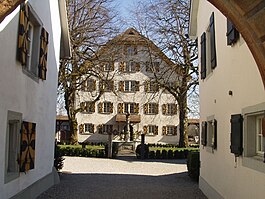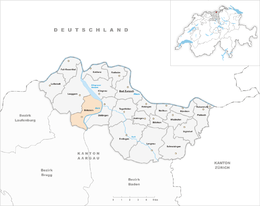Böttstein
| Böttstein | ||
|---|---|---|
 |
||
|
||
| Coordinates: 47°34′N 8°14′E / 47.567°N 8.233°ECoordinates: 47°34′N 8°14′E / 47.567°N 8.233°E | ||
| Country | Switzerland | |
| Canton | Aargau | |
| District | Zurzach | |
| Government | ||
| • Mayor | Agnes Canonica | |
| Area | ||
| • Total | 7.41 km2 (2.86 sq mi) | |
| Elevation | 356 m (1,168 ft) | |
| Population (Dec 2015) | ||
| • Total | 3,916 | |
| • Density | 530/km2 (1,400/sq mi) | |
| Postal code | 5315 (Böttstein) 5314 (Kleindöttingen) |
|
| SFOS number | 4303 | |
| Surrounded by | Döttingen, Klingnau, Leuggern, Mandach, Villigen, Würenlingen | |
| Website |
www SFSO statistics |
|
Böttstein is a municipality in the district of Zurzach in the canton of Aargau in Switzerland.
Some scattered La Tène culture items have been discovered near Böttstein. The modern village of Böttstein is first mentioned in 1087 as Botistein. During the 11th to 13th Centuries it was the seat of the lords of Böttstein, who ruled over the village. The other, neighboring villages were under the lower court of the Knights Hospitaller order house at Leuggern. After the conquest of the Aargau in 1415, the Herrschaft was held by the district of Leuggern in the County of Baden. The ownership of the administrative rights of the village wend through about ten changes until 1606 when it was bought by the von Roll family of Uri. Between 1615-17, they replaced the original castle with a late-Gothic - early Baroque mansion with chapel. Through marriage, the property came in 1674 to the Schmid family of Bellikon, who ruled over the village until 1798 and occupied the castle until 1893. The chapel of St. Anthony was given a wide range of ornamentation in the manner of Italian baroque churches with excellent stucco work, all done by northern Italian masters. In 1816 the municipality was formed by dividing the large municipality of Leuggern.
Böttstein and the other villages were part of the parish of Leuggern.
Until the late 19th Century the major economic activities were farming, viticulture and handicrafts. During the late 19th Century, the timber industry grew along the Aare river, which provided many new jobs. The new jobs along the river allowed the small village of Kleindöttingen to expand rapidly. Despite its own industry (1970-94 particle board factory, furniture factories) and numerous commercial enterprises the municipality is primarily a commuter town.
...
Wikipedia




